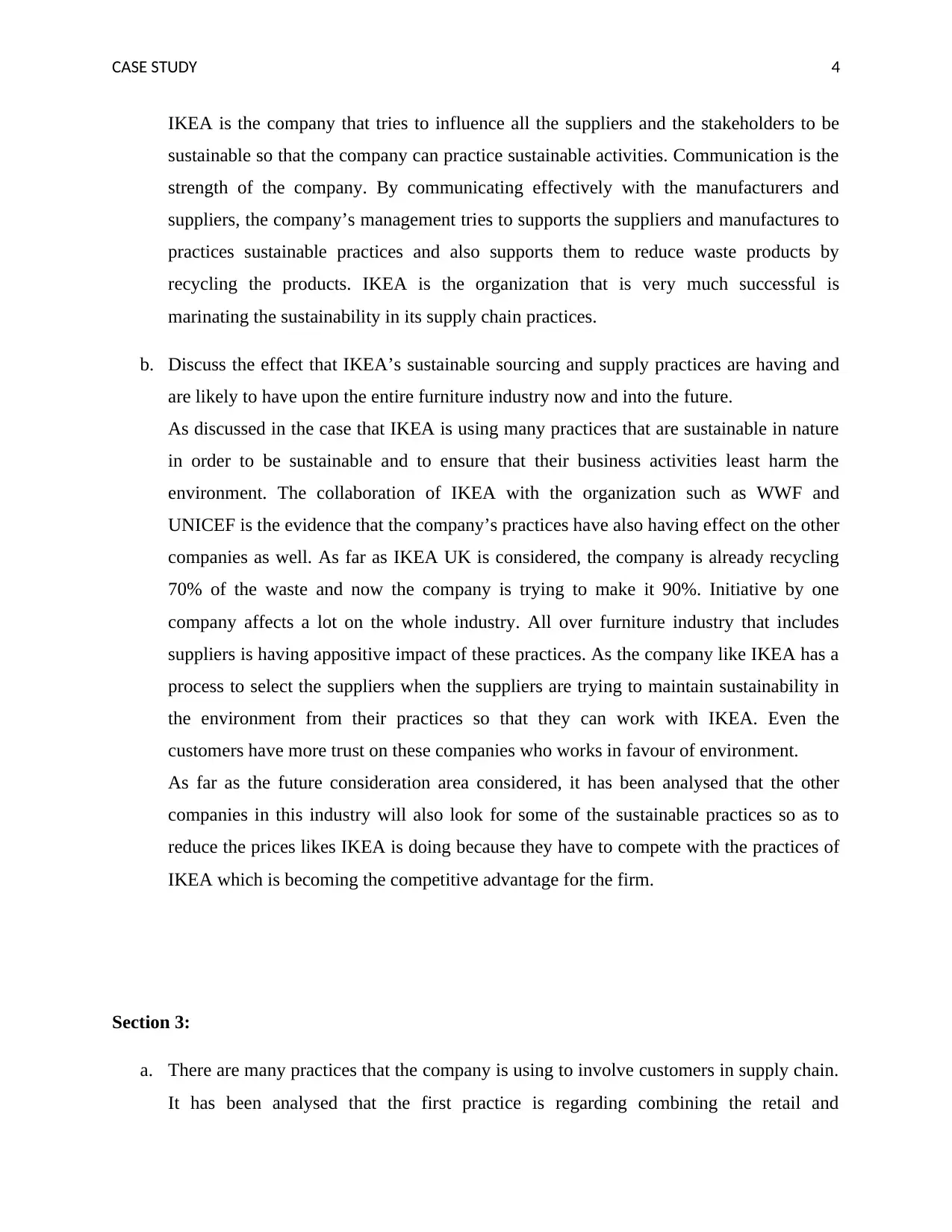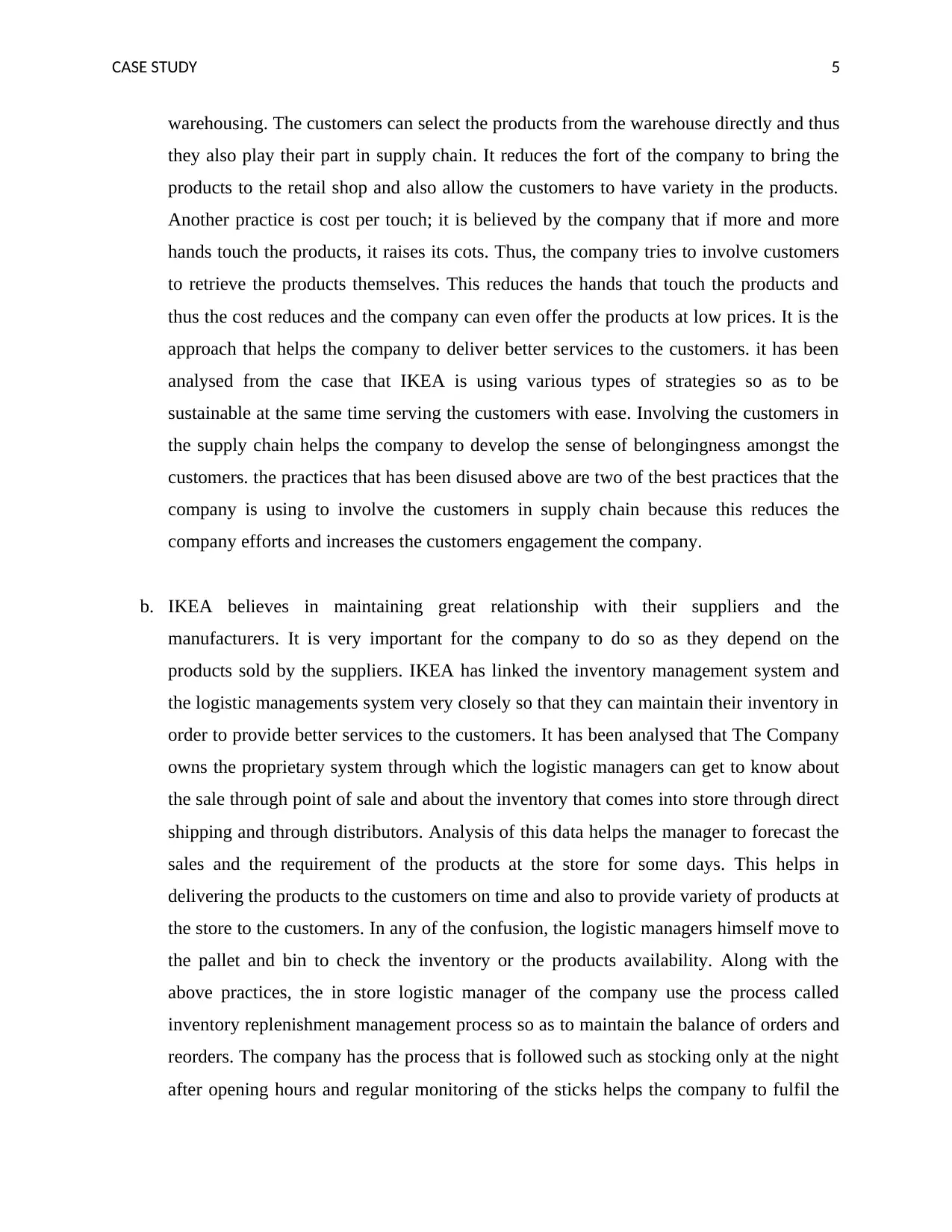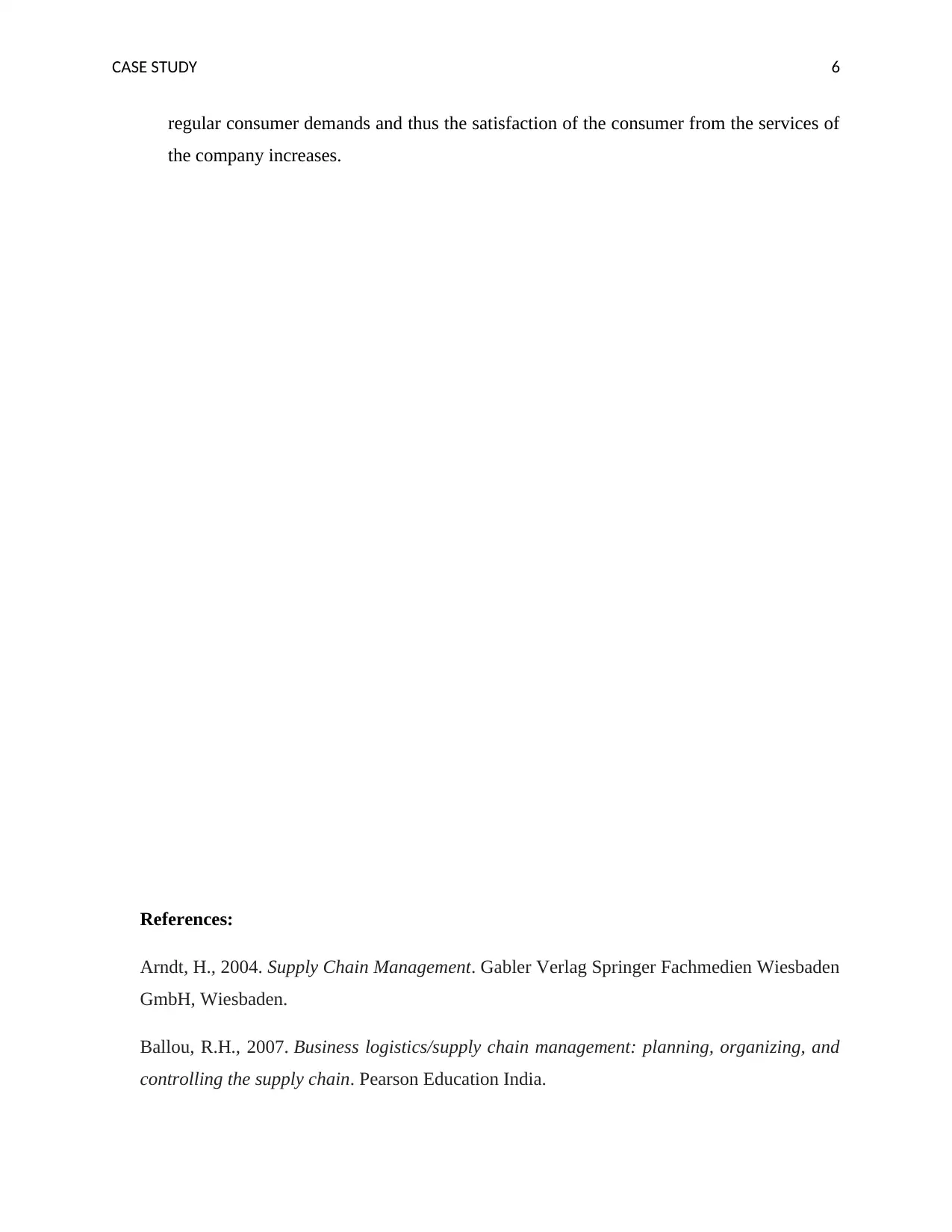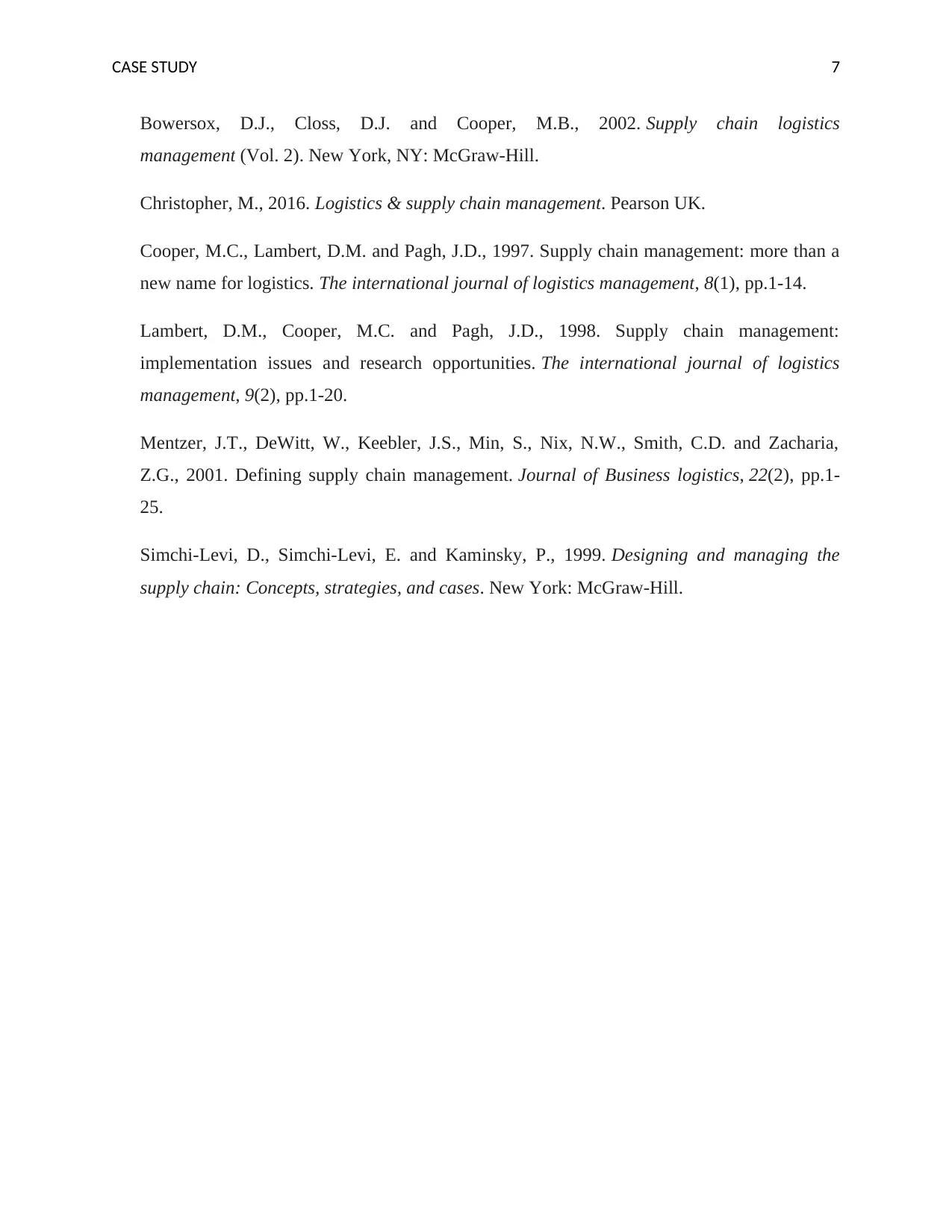IKEA's Sustainable Supply Chain: A Case Study Analysis
VerifiedAdded on 2020/05/11
|8
|2157
|175
Case Study
AI Summary
This case study examines IKEA's supply chain management, delving into its forecasting techniques, the role of 3PL, and the application of information technology. The analysis highlights IKEA's sustainable practices, including collaborations with organizations like WWF and UNICEF, and its influence on the furniture industry. The study explores IKEA's strategies for customer involvement, such as combining retail and warehousing, and the impact of these practices on cost reduction and customer engagement. Furthermore, the case study details IKEA's inventory management system and its integration with logistics to ensure efficient product delivery and customer satisfaction. The document also explores the impact of IKEA's practices on the entire furniture industry, emphasizing how the company maintains sustainability, involves its customers, and fosters strong relationships with its suppliers and manufacturers.

Running head: CASE STUDY 0
CASE STUDY
SUPPLY CHAIN MANAGEMENT
CASE STUDY
SUPPLY CHAIN MANAGEMENT
Paraphrase This Document
Need a fresh take? Get an instant paraphrase of this document with our AI Paraphraser

CASE STUDY 1
Section 1:
1. Forecasting:
a. Forecasting can be defined as the method that has been used by the businesses in order to
make future assumptions about something after analysing some data or pattern.
Forecasting in supply chain management is very essential because the company has to
make many decisions as per the forecast. The major importance of forecasting in supply
chain is that it allows the management to reduce the inventory. For example, if the
products are made according to the forecasted demand then the company needs not to
spend much on keeping the stocks and thus the cost of stocking or inventory can be
reduced (Arndt, 2004). Other importance of forecasting lies in enhancing customers
satisfaction by delivering the products as per the demands, improving the marketing and
promotion as per the availability of the products etc.
b. There are three types of forecasting in supply chain:
Demand forecast: It is the type of forecast that helps in predicting the demand of
the market as per the analysis of the market situations.
Price forecast: It is the type of forecast that deals with prediction of the price of
the products as per the pricing of the competitors and the demand of the products.
Supply forecast: supply forecast deals with the prediction of supplier’s
capabilities to supply the raw material (Bowersox, Closs and Cooper, 2002).
c. There are different loop holes that need to be analysed at the time of forecasting the
demand, supply or the price of the products. This is because these loop holes may affect
the results of forecasting. It is required by the company or the supply chain department to
look for the factors that can affect the forecasting process. Reviewing the forecast is the
necessary step to be conducted (Mentzer, 2001). Another technique that can improve the
forecasting process of capability of the company is better and efficient data collection
methods are the market analysis method because it is the most basic requirement for
forecasting.
2. 3PL:
Section 1:
1. Forecasting:
a. Forecasting can be defined as the method that has been used by the businesses in order to
make future assumptions about something after analysing some data or pattern.
Forecasting in supply chain management is very essential because the company has to
make many decisions as per the forecast. The major importance of forecasting in supply
chain is that it allows the management to reduce the inventory. For example, if the
products are made according to the forecasted demand then the company needs not to
spend much on keeping the stocks and thus the cost of stocking or inventory can be
reduced (Arndt, 2004). Other importance of forecasting lies in enhancing customers
satisfaction by delivering the products as per the demands, improving the marketing and
promotion as per the availability of the products etc.
b. There are three types of forecasting in supply chain:
Demand forecast: It is the type of forecast that helps in predicting the demand of
the market as per the analysis of the market situations.
Price forecast: It is the type of forecast that deals with prediction of the price of
the products as per the pricing of the competitors and the demand of the products.
Supply forecast: supply forecast deals with the prediction of supplier’s
capabilities to supply the raw material (Bowersox, Closs and Cooper, 2002).
c. There are different loop holes that need to be analysed at the time of forecasting the
demand, supply or the price of the products. This is because these loop holes may affect
the results of forecasting. It is required by the company or the supply chain department to
look for the factors that can affect the forecasting process. Reviewing the forecast is the
necessary step to be conducted (Mentzer, 2001). Another technique that can improve the
forecasting process of capability of the company is better and efficient data collection
methods are the market analysis method because it is the most basic requirement for
forecasting.
2. 3PL:

CASE STUDY 2
a. 3PL is the service that deals with outsourcing of the logistics functions such as
warehousing, transportation etc. it is called 3PL because third party is involved in
logistics.
b. There is various information that needs to seek from the 3PL firm. The first one is
scalability of the service. It is required to check the capability of the service to scale up
and down their services at the time of peak and lean business. Other than this, the
company also needs to take the information about the technology and the financial
stability of the company (Lambert, Cooper and Pagh, 1998).
3. Humanitarian logistics:
a. It is the branch of logistics that deals with serving the businesses at the time of any
natural calamities or emergencies.
b. The 6 key players are:
Government: The government is responsible for developing the policies as they have the
authority to mobilize the resources (Christopher, 2016).
Military: it is required to include military in this list because the soldiers are the one who
are called upon first at the time of any calamity for helping the people.
Aid agencies: These are the global actor that is supported by the government to provide
the services at the time of calamity (Ballou, 2007).
Donors: they are the one who provides funds for the programs.
NGO’s: they act as the helpers at the tie of capability.
Private organization: thy have more then on role that is they can act as donors, as helpers,
as providers etc.
4. Five (5) ways that Information Technology (IT) is being used to improve supply chain
and logistics efficiency and effectiveness.
a.
Reducing cost: implementing technological logistics helps in reducing the cost of the
activities by eliminating some of the steps that are required to be done without the use of
software (Cooper, Lambert and Pagh, 1997).
a. 3PL is the service that deals with outsourcing of the logistics functions such as
warehousing, transportation etc. it is called 3PL because third party is involved in
logistics.
b. There is various information that needs to seek from the 3PL firm. The first one is
scalability of the service. It is required to check the capability of the service to scale up
and down their services at the time of peak and lean business. Other than this, the
company also needs to take the information about the technology and the financial
stability of the company (Lambert, Cooper and Pagh, 1998).
3. Humanitarian logistics:
a. It is the branch of logistics that deals with serving the businesses at the time of any
natural calamities or emergencies.
b. The 6 key players are:
Government: The government is responsible for developing the policies as they have the
authority to mobilize the resources (Christopher, 2016).
Military: it is required to include military in this list because the soldiers are the one who
are called upon first at the time of any calamity for helping the people.
Aid agencies: These are the global actor that is supported by the government to provide
the services at the time of calamity (Ballou, 2007).
Donors: they are the one who provides funds for the programs.
NGO’s: they act as the helpers at the tie of capability.
Private organization: thy have more then on role that is they can act as donors, as helpers,
as providers etc.
4. Five (5) ways that Information Technology (IT) is being used to improve supply chain
and logistics efficiency and effectiveness.
a.
Reducing cost: implementing technological logistics helps in reducing the cost of the
activities by eliminating some of the steps that are required to be done without the use of
software (Cooper, Lambert and Pagh, 1997).
⊘ This is a preview!⊘
Do you want full access?
Subscribe today to unlock all pages.

Trusted by 1+ million students worldwide

CASE STUDY 3
Accuracy in forecasting: if the software for data analysis is used then the forecasting can
be more efficient and accurate.
Analytics: It is the very easy to record the data and makes standardization in the
processes.
Compliance: the company can easily perform as per the government requirements with
automated system.
Competitive advantage: using technology in the supply chain and logistics also helps the
company to attain competitive advantage over the competitors (Simchi-Levi, Simchi-Levi
and Kaminsky,1999).
Section 2:
a. Using the case study as a basis for your answer, describe four (4) activities that IKEA is
using to ensure its supply chain is sustainable and describe the ways that IKEA is
influencing all elements of its supply chain to adopt sustainable practices.
Activities:
1. The company works closely with the primary sector suppliers so that they can ensure
that the suppliers are using sustainable practices. During the working, the supply
chain and logistics manager of the company looks for the practices that the suppliers
are using so that they can assess whether the suppliers is harming the environment
and to which extent.
2. The company when deals with any of the suppliers try to negotiate with the prices and
also assess the environmental impacts of their practices.
3. Usage of “e-Wheel” to analyse the impact of product on the environment. It is tool
that is used by the company to check the impact of the products on the environment
so that the corrective actions can be taken if the impact is highly negative.
4. Reduction of waster by ensuring that suppliers are using the waste in producing other
products. The IWAY is the code of conduct that has been used by the company in
order to make use of the waste products.
Accuracy in forecasting: if the software for data analysis is used then the forecasting can
be more efficient and accurate.
Analytics: It is the very easy to record the data and makes standardization in the
processes.
Compliance: the company can easily perform as per the government requirements with
automated system.
Competitive advantage: using technology in the supply chain and logistics also helps the
company to attain competitive advantage over the competitors (Simchi-Levi, Simchi-Levi
and Kaminsky,1999).
Section 2:
a. Using the case study as a basis for your answer, describe four (4) activities that IKEA is
using to ensure its supply chain is sustainable and describe the ways that IKEA is
influencing all elements of its supply chain to adopt sustainable practices.
Activities:
1. The company works closely with the primary sector suppliers so that they can ensure
that the suppliers are using sustainable practices. During the working, the supply
chain and logistics manager of the company looks for the practices that the suppliers
are using so that they can assess whether the suppliers is harming the environment
and to which extent.
2. The company when deals with any of the suppliers try to negotiate with the prices and
also assess the environmental impacts of their practices.
3. Usage of “e-Wheel” to analyse the impact of product on the environment. It is tool
that is used by the company to check the impact of the products on the environment
so that the corrective actions can be taken if the impact is highly negative.
4. Reduction of waster by ensuring that suppliers are using the waste in producing other
products. The IWAY is the code of conduct that has been used by the company in
order to make use of the waste products.
Paraphrase This Document
Need a fresh take? Get an instant paraphrase of this document with our AI Paraphraser

CASE STUDY 4
IKEA is the company that tries to influence all the suppliers and the stakeholders to be
sustainable so that the company can practice sustainable activities. Communication is the
strength of the company. By communicating effectively with the manufacturers and
suppliers, the company’s management tries to supports the suppliers and manufactures to
practices sustainable practices and also supports them to reduce waste products by
recycling the products. IKEA is the organization that is very much successful is
marinating the sustainability in its supply chain practices.
b. Discuss the effect that IKEA’s sustainable sourcing and supply practices are having and
are likely to have upon the entire furniture industry now and into the future.
As discussed in the case that IKEA is using many practices that are sustainable in nature
in order to be sustainable and to ensure that their business activities least harm the
environment. The collaboration of IKEA with the organization such as WWF and
UNICEF is the evidence that the company’s practices have also having effect on the other
companies as well. As far as IKEA UK is considered, the company is already recycling
70% of the waste and now the company is trying to make it 90%. Initiative by one
company affects a lot on the whole industry. All over furniture industry that includes
suppliers is having appositive impact of these practices. As the company like IKEA has a
process to select the suppliers when the suppliers are trying to maintain sustainability in
the environment from their practices so that they can work with IKEA. Even the
customers have more trust on these companies who works in favour of environment.
As far as the future consideration area considered, it has been analysed that the other
companies in this industry will also look for some of the sustainable practices so as to
reduce the prices likes IKEA is doing because they have to compete with the practices of
IKEA which is becoming the competitive advantage for the firm.
Section 3:
a. There are many practices that the company is using to involve customers in supply chain.
It has been analysed that the first practice is regarding combining the retail and
IKEA is the company that tries to influence all the suppliers and the stakeholders to be
sustainable so that the company can practice sustainable activities. Communication is the
strength of the company. By communicating effectively with the manufacturers and
suppliers, the company’s management tries to supports the suppliers and manufactures to
practices sustainable practices and also supports them to reduce waste products by
recycling the products. IKEA is the organization that is very much successful is
marinating the sustainability in its supply chain practices.
b. Discuss the effect that IKEA’s sustainable sourcing and supply practices are having and
are likely to have upon the entire furniture industry now and into the future.
As discussed in the case that IKEA is using many practices that are sustainable in nature
in order to be sustainable and to ensure that their business activities least harm the
environment. The collaboration of IKEA with the organization such as WWF and
UNICEF is the evidence that the company’s practices have also having effect on the other
companies as well. As far as IKEA UK is considered, the company is already recycling
70% of the waste and now the company is trying to make it 90%. Initiative by one
company affects a lot on the whole industry. All over furniture industry that includes
suppliers is having appositive impact of these practices. As the company like IKEA has a
process to select the suppliers when the suppliers are trying to maintain sustainability in
the environment from their practices so that they can work with IKEA. Even the
customers have more trust on these companies who works in favour of environment.
As far as the future consideration area considered, it has been analysed that the other
companies in this industry will also look for some of the sustainable practices so as to
reduce the prices likes IKEA is doing because they have to compete with the practices of
IKEA which is becoming the competitive advantage for the firm.
Section 3:
a. There are many practices that the company is using to involve customers in supply chain.
It has been analysed that the first practice is regarding combining the retail and

CASE STUDY 5
warehousing. The customers can select the products from the warehouse directly and thus
they also play their part in supply chain. It reduces the fort of the company to bring the
products to the retail shop and also allow the customers to have variety in the products.
Another practice is cost per touch; it is believed by the company that if more and more
hands touch the products, it raises its cots. Thus, the company tries to involve customers
to retrieve the products themselves. This reduces the hands that touch the products and
thus the cost reduces and the company can even offer the products at low prices. It is the
approach that helps the company to deliver better services to the customers. it has been
analysed from the case that IKEA is using various types of strategies so as to be
sustainable at the same time serving the customers with ease. Involving the customers in
the supply chain helps the company to develop the sense of belongingness amongst the
customers. the practices that has been disused above are two of the best practices that the
company is using to involve the customers in supply chain because this reduces the
company efforts and increases the customers engagement the company.
b. IKEA believes in maintaining great relationship with their suppliers and the
manufacturers. It is very important for the company to do so as they depend on the
products sold by the suppliers. IKEA has linked the inventory management system and
the logistic managements system very closely so that they can maintain their inventory in
order to provide better services to the customers. It has been analysed that The Company
owns the proprietary system through which the logistic managers can get to know about
the sale through point of sale and about the inventory that comes into store through direct
shipping and through distributors. Analysis of this data helps the manager to forecast the
sales and the requirement of the products at the store for some days. This helps in
delivering the products to the customers on time and also to provide variety of products at
the store to the customers. In any of the confusion, the logistic managers himself move to
the pallet and bin to check the inventory or the products availability. Along with the
above practices, the in store logistic manager of the company use the process called
inventory replenishment management process so as to maintain the balance of orders and
reorders. The company has the process that is followed such as stocking only at the night
after opening hours and regular monitoring of the sticks helps the company to fulfil the
warehousing. The customers can select the products from the warehouse directly and thus
they also play their part in supply chain. It reduces the fort of the company to bring the
products to the retail shop and also allow the customers to have variety in the products.
Another practice is cost per touch; it is believed by the company that if more and more
hands touch the products, it raises its cots. Thus, the company tries to involve customers
to retrieve the products themselves. This reduces the hands that touch the products and
thus the cost reduces and the company can even offer the products at low prices. It is the
approach that helps the company to deliver better services to the customers. it has been
analysed from the case that IKEA is using various types of strategies so as to be
sustainable at the same time serving the customers with ease. Involving the customers in
the supply chain helps the company to develop the sense of belongingness amongst the
customers. the practices that has been disused above are two of the best practices that the
company is using to involve the customers in supply chain because this reduces the
company efforts and increases the customers engagement the company.
b. IKEA believes in maintaining great relationship with their suppliers and the
manufacturers. It is very important for the company to do so as they depend on the
products sold by the suppliers. IKEA has linked the inventory management system and
the logistic managements system very closely so that they can maintain their inventory in
order to provide better services to the customers. It has been analysed that The Company
owns the proprietary system through which the logistic managers can get to know about
the sale through point of sale and about the inventory that comes into store through direct
shipping and through distributors. Analysis of this data helps the manager to forecast the
sales and the requirement of the products at the store for some days. This helps in
delivering the products to the customers on time and also to provide variety of products at
the store to the customers. In any of the confusion, the logistic managers himself move to
the pallet and bin to check the inventory or the products availability. Along with the
above practices, the in store logistic manager of the company use the process called
inventory replenishment management process so as to maintain the balance of orders and
reorders. The company has the process that is followed such as stocking only at the night
after opening hours and regular monitoring of the sticks helps the company to fulfil the
⊘ This is a preview!⊘
Do you want full access?
Subscribe today to unlock all pages.

Trusted by 1+ million students worldwide

CASE STUDY 6
regular consumer demands and thus the satisfaction of the consumer from the services of
the company increases.
References:
Arndt, H., 2004. Supply Chain Management. Gabler Verlag Springer Fachmedien Wiesbaden
GmbH, Wiesbaden.
Ballou, R.H., 2007. Business logistics/supply chain management: planning, organizing, and
controlling the supply chain. Pearson Education India.
regular consumer demands and thus the satisfaction of the consumer from the services of
the company increases.
References:
Arndt, H., 2004. Supply Chain Management. Gabler Verlag Springer Fachmedien Wiesbaden
GmbH, Wiesbaden.
Ballou, R.H., 2007. Business logistics/supply chain management: planning, organizing, and
controlling the supply chain. Pearson Education India.
Paraphrase This Document
Need a fresh take? Get an instant paraphrase of this document with our AI Paraphraser

CASE STUDY 7
Bowersox, D.J., Closs, D.J. and Cooper, M.B., 2002. Supply chain logistics
management (Vol. 2). New York, NY: McGraw-Hill.
Christopher, M., 2016. Logistics & supply chain management. Pearson UK.
Cooper, M.C., Lambert, D.M. and Pagh, J.D., 1997. Supply chain management: more than a
new name for logistics. The international journal of logistics management, 8(1), pp.1-14.
Lambert, D.M., Cooper, M.C. and Pagh, J.D., 1998. Supply chain management:
implementation issues and research opportunities. The international journal of logistics
management, 9(2), pp.1-20.
Mentzer, J.T., DeWitt, W., Keebler, J.S., Min, S., Nix, N.W., Smith, C.D. and Zacharia,
Z.G., 2001. Defining supply chain management. Journal of Business logistics, 22(2), pp.1-
25.
Simchi-Levi, D., Simchi-Levi, E. and Kaminsky, P., 1999. Designing and managing the
supply chain: Concepts, strategies, and cases. New York: McGraw-Hill.
Bowersox, D.J., Closs, D.J. and Cooper, M.B., 2002. Supply chain logistics
management (Vol. 2). New York, NY: McGraw-Hill.
Christopher, M., 2016. Logistics & supply chain management. Pearson UK.
Cooper, M.C., Lambert, D.M. and Pagh, J.D., 1997. Supply chain management: more than a
new name for logistics. The international journal of logistics management, 8(1), pp.1-14.
Lambert, D.M., Cooper, M.C. and Pagh, J.D., 1998. Supply chain management:
implementation issues and research opportunities. The international journal of logistics
management, 9(2), pp.1-20.
Mentzer, J.T., DeWitt, W., Keebler, J.S., Min, S., Nix, N.W., Smith, C.D. and Zacharia,
Z.G., 2001. Defining supply chain management. Journal of Business logistics, 22(2), pp.1-
25.
Simchi-Levi, D., Simchi-Levi, E. and Kaminsky, P., 1999. Designing and managing the
supply chain: Concepts, strategies, and cases. New York: McGraw-Hill.
1 out of 8
Related Documents
Your All-in-One AI-Powered Toolkit for Academic Success.
+13062052269
info@desklib.com
Available 24*7 on WhatsApp / Email
![[object Object]](/_next/static/media/star-bottom.7253800d.svg)
Unlock your academic potential
Copyright © 2020–2025 A2Z Services. All Rights Reserved. Developed and managed by ZUCOL.





